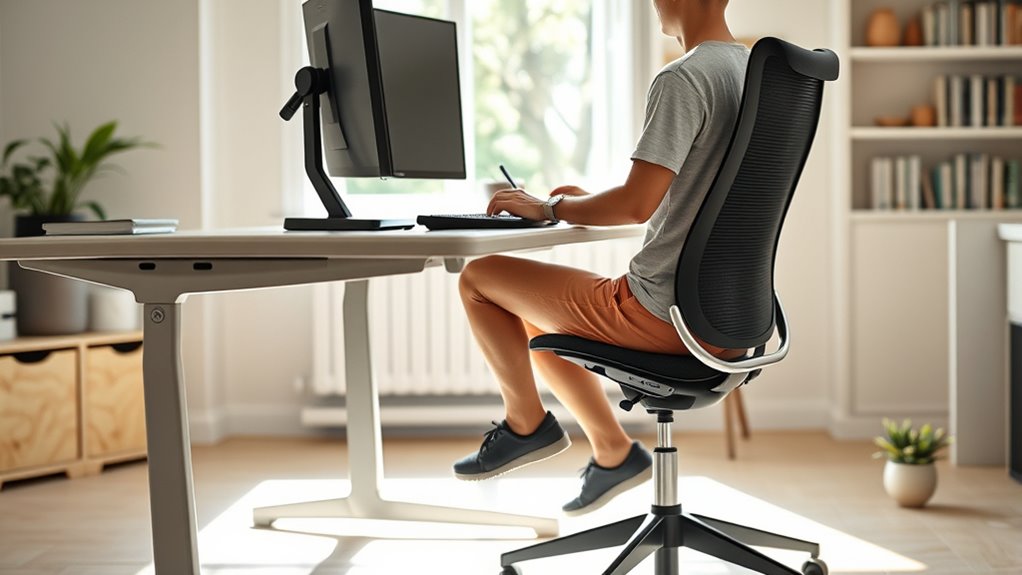To prevent musculoskeletal pain while working remotely, you should set up your workspace thoughtfully. Organize essentials within easy reach, use an ergonomic chair with lumbar support, and position your monitor at eye level about an arm’s length away. Take regular breaks to stretch and move, and use supportive accessories like cushions or ergonomic keyboards. Maintaining good posture and incorporating movement will help you stay comfortable and focused—stay tuned to learn even more tips for a healthy work environment.
Key Takeaways
- Arrange your workspace with essentials within reach, eliminate clutter, and optimize lighting for better posture and focus.
- Choose ergonomic furniture with proper lumbar support, adjustable height, and supportive cushions to maintain natural spinal alignment.
- Position monitors at eye level and at an arm’s length distance to reduce neck strain and eye fatigue.
- Use ergonomic keyboards, mice, and accessories to keep wrists straight and relaxed, minimizing repetitive strain.
- Take regular breaks to stretch, move, and reset posture, preventing musculoskeletal discomfort and promoting circulation.
Assessing Your Workspace Layout
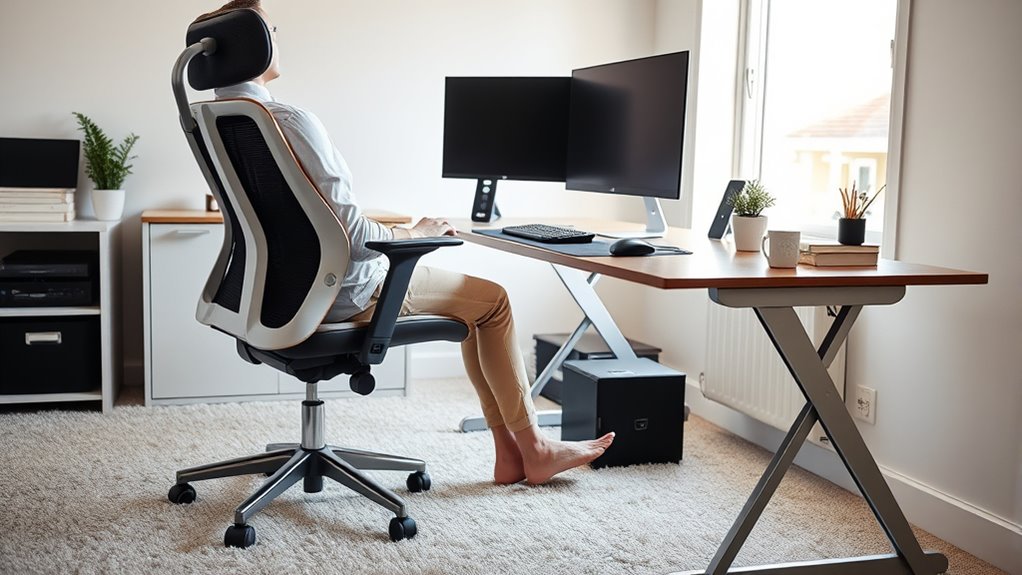
To create a comfortable and productive remote workspace, you need to assess your current layout critically. Start by examining your workspace organization—ensure your essentials are within easy reach to avoid unnecessary strain. Clear clutter and arrange items logically to promote efficiency. Next, focus on lighting optimization; natural light is ideal, so position your desk near windows if possible. Supplement with adjustable lighting to reduce eye strain during late hours or overcast days. Proper lighting minimizes glare and shadows, helping you maintain good posture and focus. Additionally, consider incorporating ergonomic principles into your setup to further prevent musculoskeletal issues. Take note of your monitor placement, making sure it’s at eye level to prevent neck strain. Regularly reevaluate your setup, making adjustments as needed to enhance comfort and prevent musculoskeletal issues, and stay informed about factors influencing comfort to optimize your workspace effectively. Incorporating AI-driven ergonomic assessments can provide personalized recommendations to improve your workspace setup further.
Choosing the Right Desk and Chair
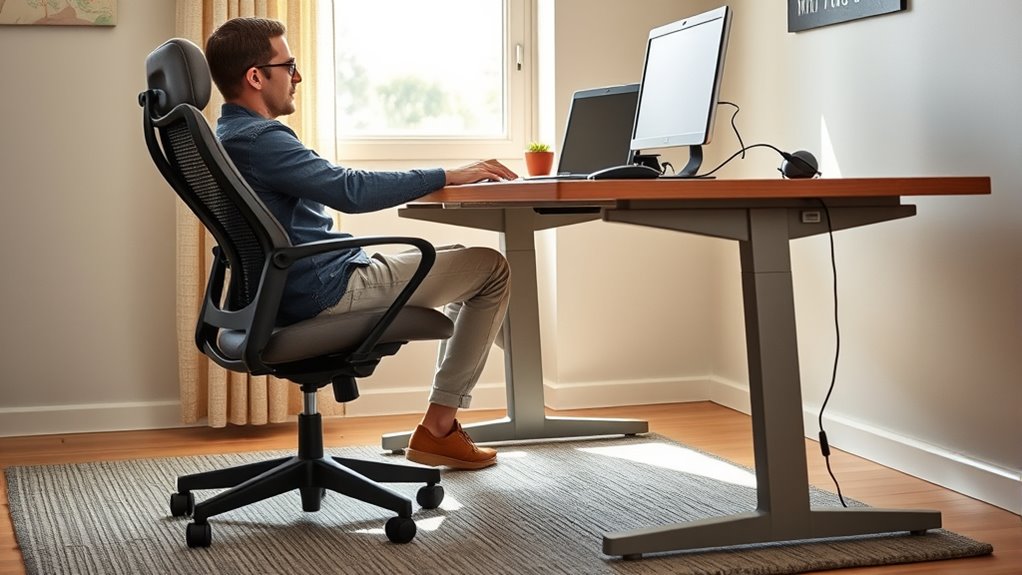
Selecting the right desk and chair sets the foundation for a comfortable and efficient remote workspace. When choosing a desk, consider desk materials like sturdy wood or metal, which offer durability and stability. Avoid flimsy furniture that can cause discomfort or strain over time. Your chair color can also influence your mood; opt for calming shades like blue or neutral tones to promote focus. Ensure the chair provides proper lumbar support and adjustable height to fit your body. A well-chosen desk and chair improve posture, reduce fatigue, and prevent musculoskeletal pain. Proper posture is essential in minimizing long-term discomfort and maximizing comfort during extended work sessions. Additionally, selecting ergonomic furniture that supports natural movement can help prevent issues related to repetitive strain injuries.
Proper Monitor and Screen Positioning

Ensuring your monitor and screen are positioned correctly is essential for reducing eye strain and maintaining good posture during long work sessions. Position your monitor so that the top of the screen is at or just below eye level, keeping your neck relaxed. Adjust the monitor to minimize monitor glare by avoiding windows or bright lights directly behind or in front of the screen. Use an anti-glare screen if needed. Also, set your screen brightness to match the ambient lighting; too bright or dim screens cause eye fatigue. Keep the monitor about an arm’s length away to prevent leaning forward. Proper placement reduces strain on your eyes and neck, helping you stay comfortable and focused throughout your workday. Be aware that support hours for your devices may vary, so plan your setup during times when assistance is available if needed.
Ergonomic Keyboard and Mouse Use

To prevent strain, you should adjust your hand position so your wrists stay straight and relaxed. Choosing ergonomic keyboards and mice can make a big difference in reducing discomfort during long hours. By selecting the right devices and positioning your hands properly, you’ll work more comfortably and efficiently. Additionally, understanding workspace setup and proper workspace setup can further enhance your ergonomic practices. Incorporating antioxidant-rich honey into your diet can also support overall health, including reducing inflammation and supporting tissue repair.
Adjust Hand Position Properly
Proper hand positioning is essential for preventing strain and discomfort while using your keyboard and mouse. To maintain good wrist alignment, keep your hands relaxed and your wrists straight, avoiding bending upward or downward. Proper hand positioning reduces the risk of musculoskeletal pain and improves comfort during long work sessions. Incorporating ergonomic accessories such as ergonomic keyboards can further promote correct hand posture and reduce fatigue. To guarantee correct wrist alignment, proper ergonomic setup is crucial—adjust your workspace so your keyboard and mouse are at a height that allows your elbows to stay close to your body. Additionally, taking regular breaks to stretch and reset your hand position can help prevent repetitive strain injuries, promoting long-term comfort and health.
Select Ergonomic Devices
Choosing the right ergonomic keyboard and mouse can make a significant difference in reducing strain and preventing discomfort during your workday. When selecting ergonomic devices, focus on workspace customization to fit your unique needs. Look for devices that promote a neutral wrist position and minimize repetitive motion. Prioritize adjustable features, such as height and tilt, to optimize comfort. Incorporating ergonomic design principles can further enhance your workstation setup and help prevent musculoskeletal issues. Additionally, selecting devices with proper filtration and pump protection features ensures smooth operation and longevity of your equipment, which contributes to a more comfortable and efficient workspace. Being mindful of ergonomic device features can also improve overall comfort and reduce fatigue.
Maintaining Good Posture Throughout the Day

To stay comfortable and prevent strain, you should regularly adjust your chair and desk to support good posture. Make sure your screen is at eye level to avoid neck stress. Small tweaks like these can make a big difference in keeping you comfortable all day long. Incorporating ergonomic principles into your workspace can further enhance your posture and prevent musculoskeletal discomfort. Using specialized ergonomic tools, such as supportive cushions or adjustable stands, can provide additional comfort during long working hours. Additionally, adopting Victoriana-inspired ergonomic designs can add a touch of style while promoting proper alignment.
Ergonomic Seating Adjustments
Are you guaranteeing your chair and desk setup support good posture throughout the day? Proper ergonomic seating adjustments can make a big difference in preventing discomfort. Focus on selecting cushioning options that provide firm yet comfortable support, reducing pressure points. Adjust your lumbar support so it fits snugly against your lower back, maintaining the natural curve of your spine. Ensure your chair height allows your feet to rest flat on the floor and your knees are at a 90-degree angle. Keep your hips level and avoid slouching or leaning forward. Remember, small adjustments can promote better circulation and reduce strain, helping you stay comfortable and focused during long work hours.
- Proper cushioning options prevent discomfort and improve support
- Lumbar support helps maintain the spine’s natural curve
- Correct chair height promotes better posture and circulation
Proper Screen Alignment
Maintaining proper screen alignment is essential for preventing neck and eye strain during long work sessions. Position your monitor so that the top of the screen is at or slightly below eye level, allowing your gaze to naturally fall downward. Keep the screen about an arm’s length away to reduce the need to lean forward or strain your eyes. Proper alignment enhances visual comfort and minimizes eye strain, especially during extended periods of focus. Adjust brightness and contrast settings to match your environment, reducing glare and improving clarity. Regularly check your posture and screen position to ensure you’re not tilting your head or squinting. By preserving good screen alignment, you support healthy posture and prevent discomfort that can develop from prolonged poor visual habits. Being aware of ergonomic best practices can further help you maintain comfort throughout your workday. Incorporating vertical storage solutions can also keep your workspace organized, reducing visual clutter that contributes to distraction and fatigue.
Incorporating Movement and Stretch Breaks

Incorporating movement and stretch breaks into your daily routine is essential for maintaining energy and preventing discomfort during long work hours. Regular breaks help reduce muscle tension and improve circulation, making it easier to stay focused. Use movement reminders to prompt you to stand up, stretch, or walk around every hour. Incorporate simple stretching routines that target your neck, shoulders, and back to ease strain. These small actions can markedly reduce the risk of musculoskeletal pain. Remember, consistency is key—make breaks a non-negotiable part of your workday. By prioritizing movement, you’ll boost both your comfort and productivity.
- Set alarms or app alerts to remind you to move
- Focus on stretching routines that target key tension areas
- Take short walks to refresh your mind and body
Enhancing Comfort With Supportive Accessories
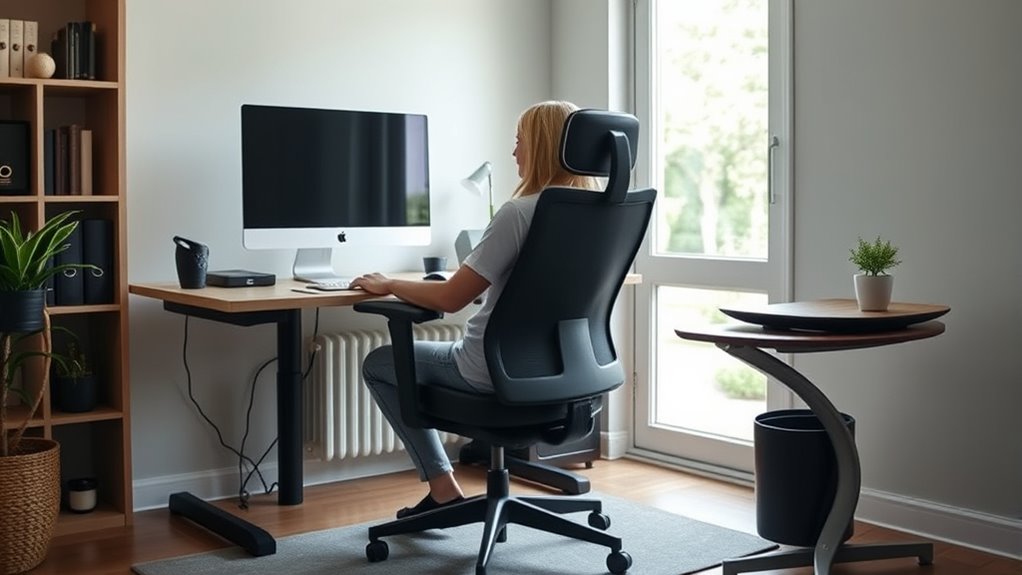
Adding supportive accessories to your workspace can substantially improve comfort and reduce strain during long hours at your desk. Using a cushion that offers stability helps maintain proper posture and prevents discomfort from uneven surfaces. Look for cushions with good cushion stability to guarantee they stay in place and provide consistent support. Armrest padding also plays a crucial role in reducing shoulder and neck tension. Choose adjustable armrest pads that conform to your arm’s shape, offering soft yet firm support. These accessories help keep your muscles relaxed and support natural alignment. Incorporating supportive accessories is a simple, effective way to enhance your ergonomic setup, minimize musculoskeletal pain, and make your remote work experience more comfortable throughout the day.
Developing Healthy Work Habits and Routines
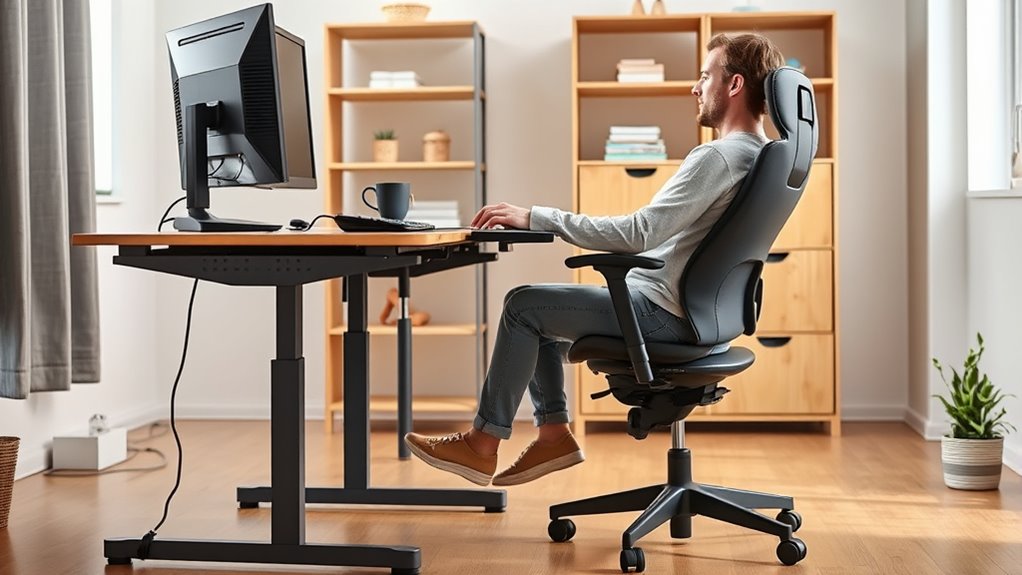
To stay productive and prevent fatigue, developing healthy work habits and routines is essential when working remotely. Consistent routines help you manage your time effectively and reduce physical strain. Incorporate healthy snack options to keep your energy steady and avoid crashes. Use time management techniques like the Pomodoro method to stay focused and prevent burnout. Establishing regular start and finish times creates boundaries between work and personal life, promoting better ergonomics and mental health.
- Schedule breaks to stretch and reset, reducing musculoskeletal discomfort
- Plan nutritious snacks to sustain energy without overeating
- Set specific work hours to maintain a healthy work-life balance
Frequently Asked Questions
How Can I Customize My Ergonomic Setup for Different Tasks?
To customize your ergonomic setup for different tasks, start with desk customization to suit each activity. Adjust your chair height and monitor position for desk work, and switch to a standing desk or add a supportive mat for tasks that require movement. Incorporate task-specific ergonomics by using specialized tools or supports. This way, you guarantee comfort and efficiency, reducing strain no matter what task you’re doing.
What Are Signs of Developing Musculoskeletal Issues at Home?
If you’re ignoring posture awareness and pushing through muscle fatigue, you might soon notice warning signs of musculoskeletal issues. These include persistent aches, tingling or numbness, stiffness, or joint pain that doesn’t go away. You may also feel weakness or a burning sensation in your muscles. Pay attention to these signals, because ignoring them could turn minor discomfort into serious, long-term problems. Stop, assess, and improve your ergonomic habits before things worsen.
Are There Specific Ergonomic Guidelines for Standing Desks?
Standing desks offer many benefits, like reducing back pain and boosting energy, but you should follow ergonomic guidelines to get the most out of them. Keep your monitor at eye level, adjust the desk height so your elbows are at 90 degrees, and use ergonomic accessories like anti-fatigue mats and footrests. These tips help maintain proper posture, prevent strain, and maximize the benefits of your standing desk.
How Often Should I Consult a Professional for Ergonomic Assessments?
You should schedule an ergonomic assessment whenever you notice discomfort or after making significant changes to your workspace. Generally, a professional consultation schedule recommends revisiting your setup every 6 to 12 months to ensure proper support. Regular ergonomic assessments help identify issues early, prevent pain, and optimize your workspace. Keep track of your comfort levels and seek professional advice as needed, especially if you experience persistent aches or new symptoms.
What Ergonomic Practices Are Recommended for Shared Workspaces at Home?
Imagine you’re a skilled conductor harmonizing a symphony—your workspace is the orchestra. For shared home workspaces, you should organize your desk to keep essentials within reach, like tuning your instruments. Optimize lighting to reduce eye strain, much like adjusting the spotlight for clarity. Proper desk organization and lighting guarantee comfort and productivity, preventing musculoskeletal issues and creating a balanced, efficient environment for everyone sharing the space.
Conclusion
So, after all this advice, you might think it’s easy to stay comfortable and pain-free. But let’s be honest—how often do you actually pause to adjust your setup or take breaks? Irony isn’t lost when you realize that the best way to prevent pain is simply paying attention to small, consistent habits. So go ahead, ignore that advice—until your back reminds you why it mattered all along.
